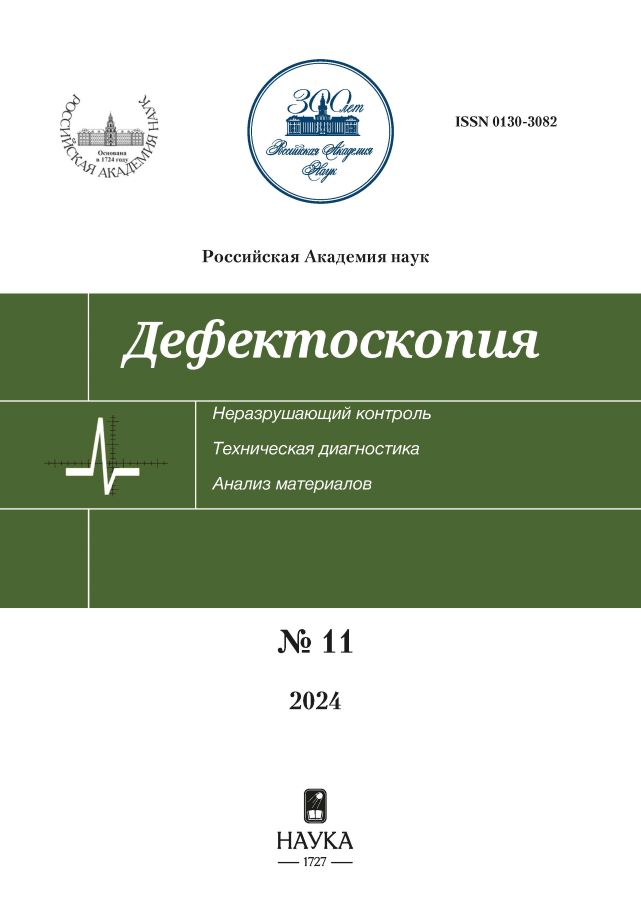Research on ultrasonic synchronous detection method for material residual stress and thickness
- Авторлар: Zhao W.1, Zhou B.2,3, Bai W.2, Wang Z.2
-
Мекемелер:
- 1Shanghai Institute of Technology
- Shanghai Institute of Technology
- Suzhou Aisierti Technology Co., Ltd
- Шығарылым: № 11 (2024)
- Беттер: 30-45
- Бөлім: Acoustic methods
- URL: https://rjdentistry.com/0130-3082/article/view/649294
- DOI: https://doi.org/10.31857/S0130308224110037
- ID: 649294
Дәйексөз келтіру
Аннотация
Being limited to the different transmission and reception modes and detection signals of the critical refracted longitudinal wave method for stress measurement and the perpendicular incident echo method for thickness measurement, it is necessary to use different probes and equipments when simultaneously measuring stress and thickness. For this difficulty, the acquisition frequency and the number of bits are taken as the research object to realize the optimization of the echo signal. By combining FEM simulations with Comsol software with experimental research, the effects of probe incidence angle, probe spacing, and temperature on ultrasonic waves are investigated, and the relationship between probe spacing and the stress coefficient of measured component (K) is analyzed. A novel ultrasonic synchronous detection method for residual stress and thickness is proposed. This method is based on an integrated transmit-receive probe with oblique incidence, utilizing critical refracted longitudinal wave (LCR wave) for stress detection and synchronously generated transverse waves for thickness measurement. For the first time, a formula for ultrasonic thickness measurement based on inclined incidence is derived. Using self-developed equipment, ultrasonic testing experiments on step test block and cantilever beam loading device were conducted to verify the accuracy and precision of the proposed synchronous detection method for stress and thickness. This method has significant application prospects in the inspection or online monitoring of pressure vessels concerned with fatigue and corrosion performance.
Толық мәтін
Авторлар туралы
Wentong Zhao
1Shanghai Institute of Technology
Хат алмасуға жауапты Автор.
Email: zb521a@sina.com
ҚХР, 201418 Shanghai
Bing Zhou
Shanghai Institute of Technology; Suzhou Aisierti Technology Co., Ltd
Email: zb521a@sina.com
ҚХР, 201418 Shanghai
Wenrui Bai
Shanghai Institute of Technology
Email: zb521a@sina.com
ҚХР, 201418 Shanghai
Zhanyong Wang
Shanghai Institute of Technology
Email: zb521a@sina.com
ҚХР, 201418 Shanghai
Әдебиет тізімі
- Jinyao D., Kai S., Wenyu X., Guangming J., Chuang S. Application of Alternating Current Stress Measurement Method in the Stress Detection of Long-Distance Oil Pipelines % // J. Energies. 2022. V. 15 (14). P. 4965—4965. https://doi.org/10.3390/EN15144965
- Zhao Wei. Research on Stress Detection Methods of Steel Structures Using Critically Refracted Longitudinal Waves Ultrasonic Method // Sichuan Building Science Research. 2023. V. 49 (02). P. 58—66. https://doi.org/10.19794/j.cnki.1008-1933.2023.0021
- Chaki S., Ke W., Demouveau H. Numerical and experimental analysis of the critically refracted longitudinal beam // Ultrasonics. 2013. V. 53 (1). P. 65—69. https://doi.org/10.1016/j.ultras.2012.03.014
- Yu Wenguang, Li Yukun, Zhang Mengxian et al. Quantitative Analysis of Main Influencing Factors in Measuring Pipeline Stress Using Ultrasonic Method // Nondestructive Testing. 2019. V. 41 (8). P. 11—15. https://doi.org/10.11973/wsjc201908003
- Nicolás P. Y. M. M., Flávio B. et al. Self-compensation methodology for ultrasonic thickness gauges // Ultrasonics. 2023. P. 135107105—107105. https://doi.org/10.1016/J.ULTRAS.2023.107105
- Rose L.J. Ultrasonic Guided Waves in Solid Media. Cambridge University Press, 2014. P. 06—15. https://doi.org/10.1017/CBO9781107273610
- Song Wentao, Pan Qinxue, Xu Chunguang et al. Residual Stress Nondestructive Testing for Pipe Component Based on Ultrasonic Method / 2014 Far East Forum on Nondestructive Evaluation/Testing: New Technology&Application. 2014. P. 163—167. https://doi.org/10.1109/FENDT.2014.6928254
- He Jingbo. Absolute Axial Stress Detection Method of Steel Components Based on Ultrasonic Method. Harbin Institute of Technology, 2020. https://doi.org/10.27061/d.cnki.ghgdu.2020. 005113
- Hou Huaishu, Fang Xinchong, Zhang Runze et al. Thin-walled metal round straight seam welded pipe residual stress ultrasonic testing // Manufacturing technology and machine tools. 2022. No. 02. P. 126—130. https://link.cnki.net/doi/10.19287/j.cnki.1005-2402.2022.02.023
- Shuai Zhuming, Jia Guangming, Cheng Zhiqiang. Calibration and Analysis of Ultrasonic Stress Coefficient Based on Finite Element Simulation // APPLIED ACOUSTICS. 2024. V. 43 (02). P. 461—468. https://doi.org/10.11684/j.issn.1000-310X.2024.02.026
- Yu Wenguang. Research on Key Technologies of Ultrasonic Non-Destructive Testing for Pipeline Stress. China University of Petroleum (East China), 2019. https://doi.org/10.27644/d.cnki.gsydu.2019.000621
- Guo Mocheng. Research and Correction of Stress Detection Influencing Factors Based on Critical Refraction Longitudinal Wave Method. Sichuan Agricultural University, 2021. https://doi.org/10.27345/d.cnki.gsnyu.2021.000437
- Yang Shunmin, Mingquan Wang, Lu Yang. Investigation of Uncertain Factors on Measuring Residual Stress with Critically Refracted Longitudinal Waves // Applied Sciences. 2019. V. 9. No. 3. P. 485. https://doi.org/10.3390/app9030485
- Egle D.M., Bray D.E. Measurement of acoustoelastic and third-order elastic constants for rail steel // J. Acoust. Soc. Am. 1 September 1976. V. 60 (3). P. 741—744. https://doi.org/10.1121/1.381146
- Yang Shunmin. Research on Key Influencing Factors of Residual Stress Detection by Critical Refraction Longitudinal Wave. North University of China, 2019. https://doi.org/10.27470/d.cnki.ghbgc.2019.000005
- Jia D., Bourse G., Chaki S. et al. Investigation of Stress and Temperature Effect on the Longitudinal Ultrasonic Waves in Polymers // Research in Nondestructive Evaluation. 2014. V. 25 (1). P. 20—29. https://doi.org/10.1080/09349847.2013.820371
- Pan Qinxue, Shao Sing, XIAO Dingguo et al. Research on Ultrasonic testing method of Bolt tightening Force Based on Form factor // Acta Armmarii. 2019. V. 40 (04). P. 880—888. https://doi.org/10.3969/j.issn.1000-1093.2019.04.024
- Niu Xiaochuan, Zhu Liqiang, Yu Zujun et al. Seamless rail the effect of temperature on the stress of nonlinear ultrasonic testing in the // Acta. 2019. V. 44 (02). P. 241—250. https://doi.org/10.15949 / j.carol carroll nki. 0371-0025.2019.02.011
- Zhang Y.C. Study on the influence of temperature effect on ultrasonic Testing of axial stress of steel members. Harbin Institute of Technology, 2022. https://doi.org/10.27061/ d.cnki.ghgdu.2022.001344
Қосымша файлдар



















